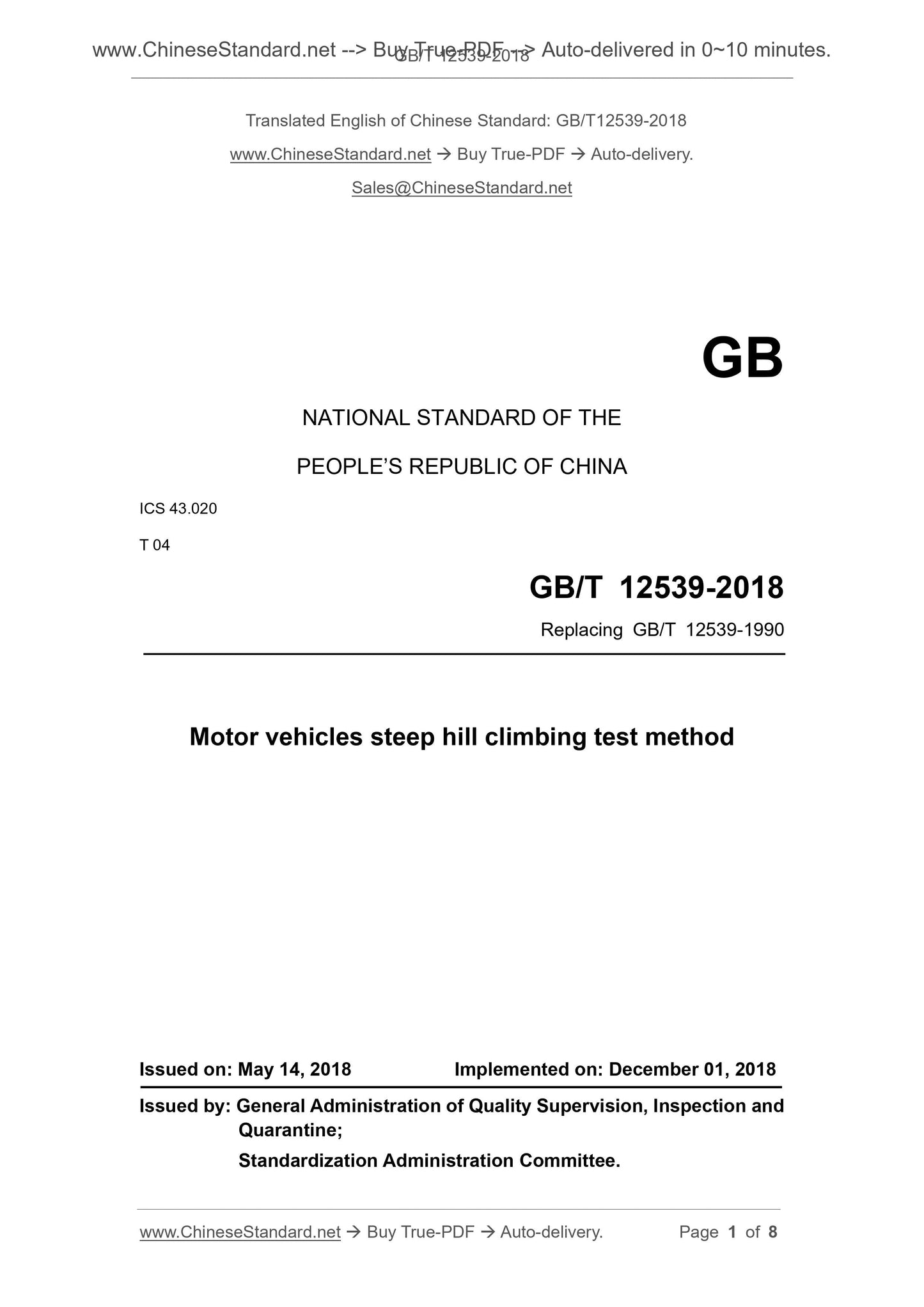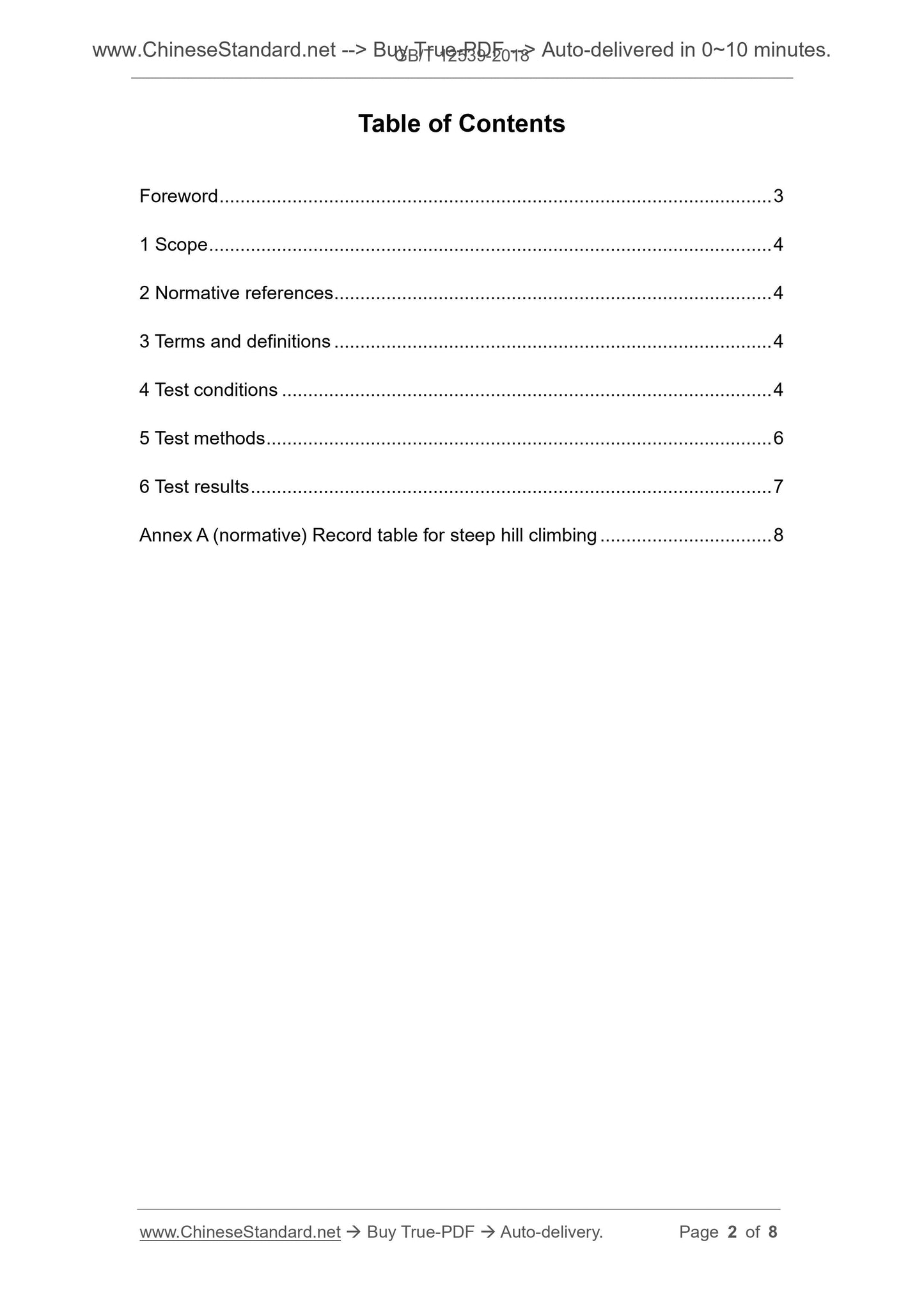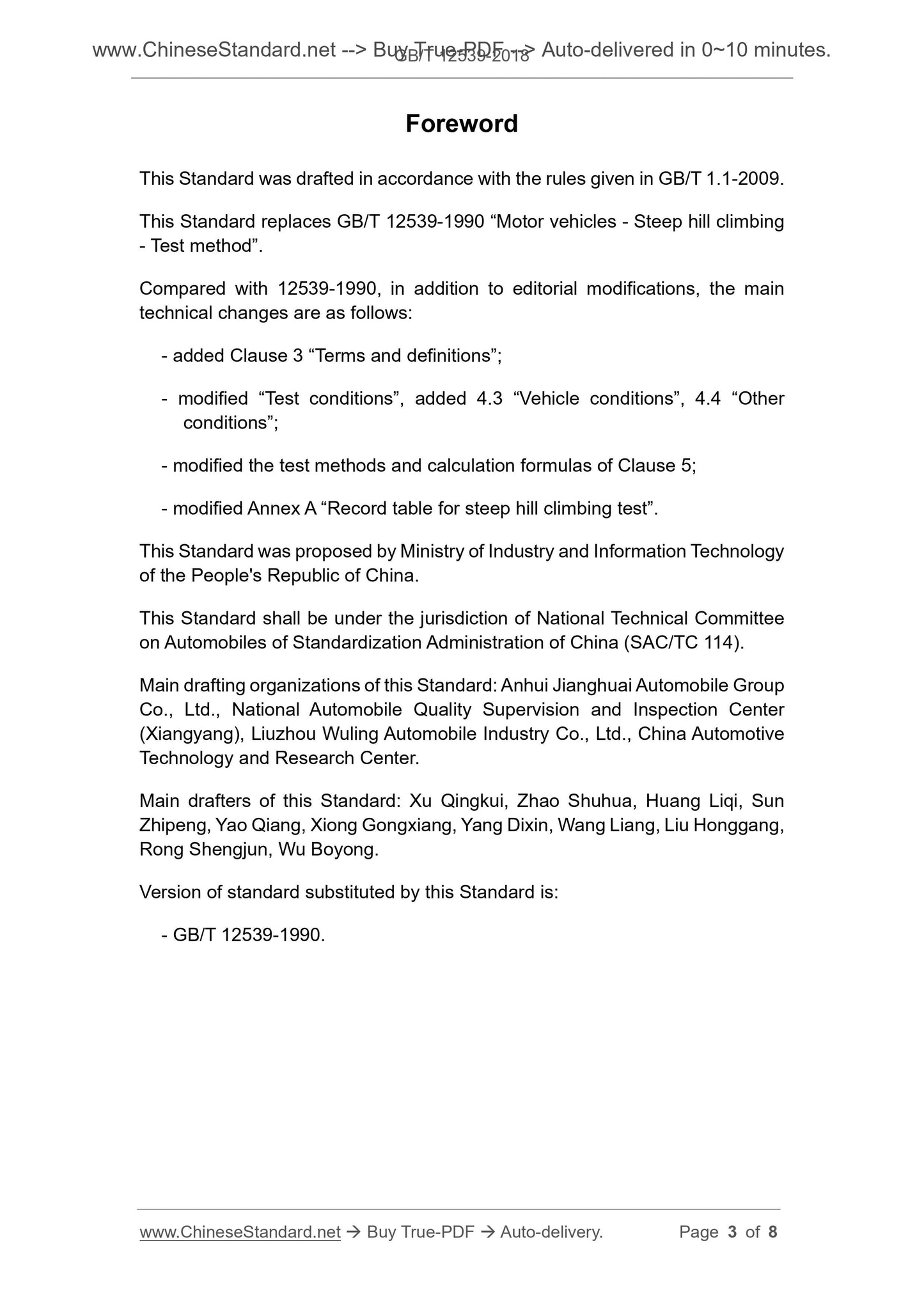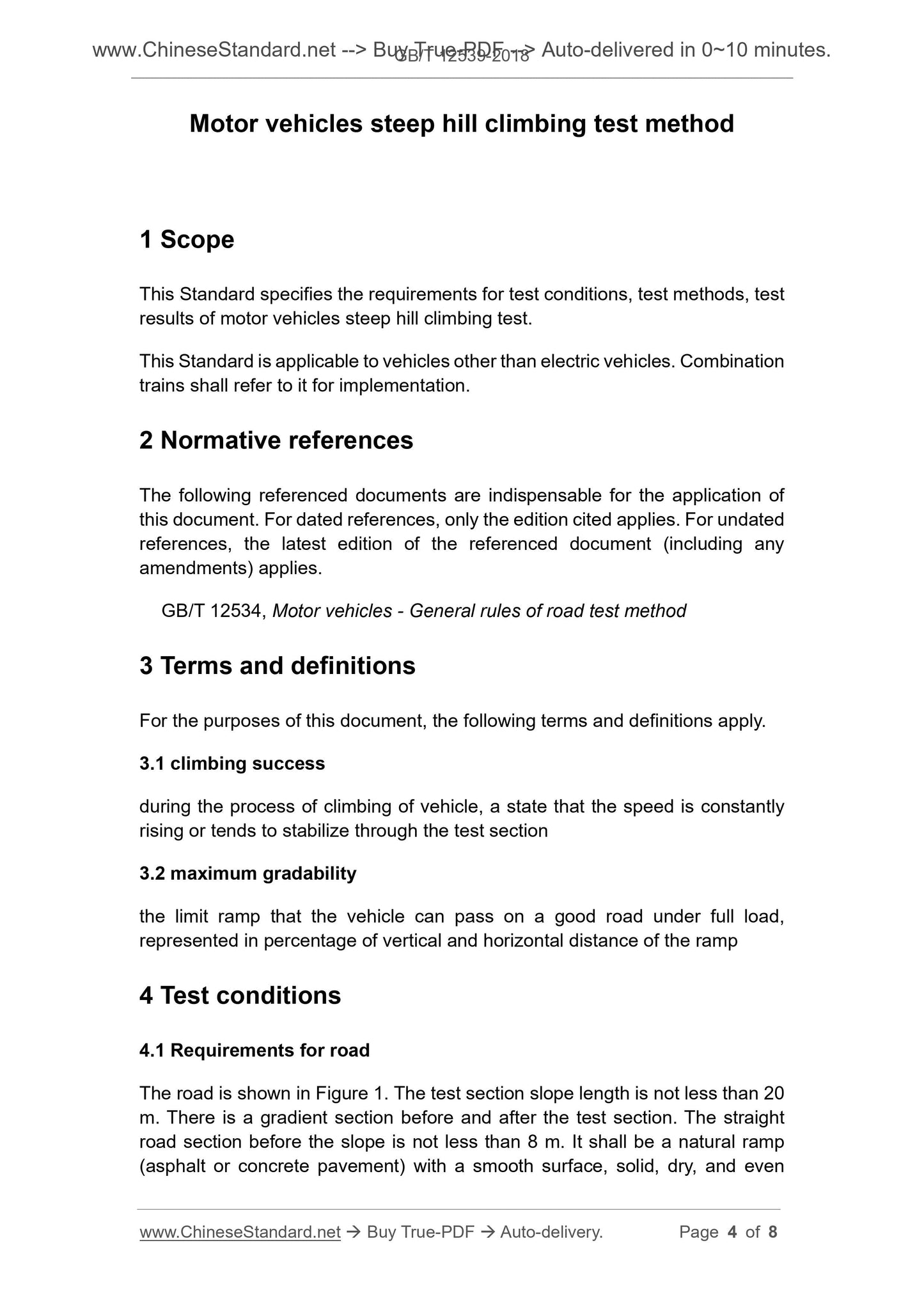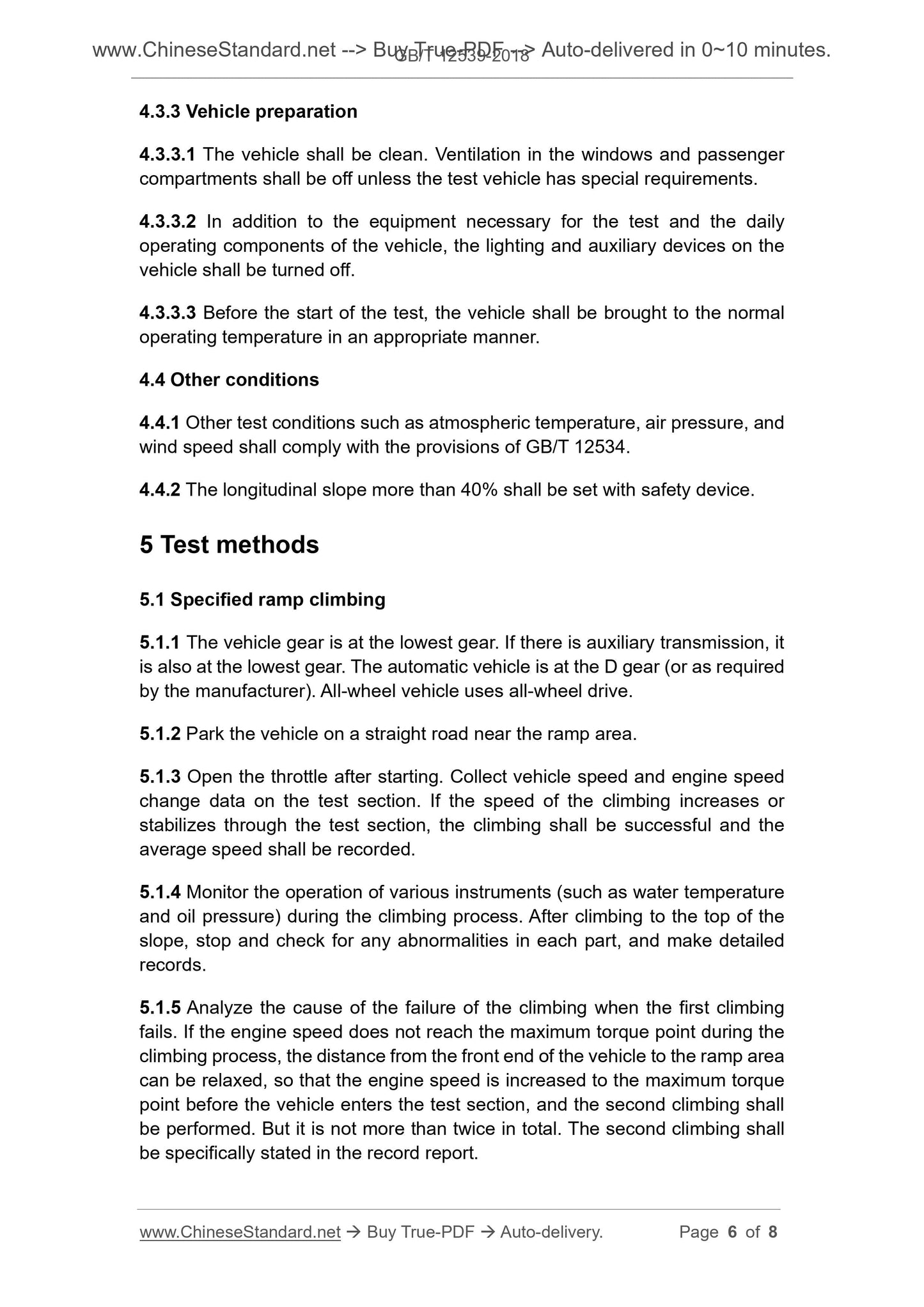1
/
of
5
www.ChineseStandard.us -- Field Test Asia Pte. Ltd.
GB/T 12539-2018 English PDF (GB/T12539-2018)
GB/T 12539-2018 English PDF (GB/T12539-2018)
Regular price
$85.00
Regular price
Sale price
$85.00
Unit price
/
per
Shipping calculated at checkout.
Couldn't load pickup availability
GB/T 12539-2018: Motor vehicles steep hill climbing test method
Delivery: 9 seconds. Download (& Email) true-PDF + Invoice.
Get Quotation: Click GB/T 12539-2018 (Self-service in 1-minute)
Historical versions (Master-website): GB/T 12539-2018
Preview True-PDF (Reload/Scroll-down if blank)
GB/T 12539-2018
GB
NATIONAL STANDARD OF THE
PEOPLE’S REPUBLIC OF CHINA
ICS 43.020
T 04
Replacing GB/T 12539-1990
Motor vehicles steep hill climbing test method
ISSUED ON. MAY 14, 2018
IMPLEMENTED ON. DECEMBER 01, 2018
Issued by. General Administration of Quality Supervision, Inspection and
Quarantine;
Standardization Administration Committee.
Table of Contents
Foreword ... 3
1 Scope ... 4
2 Normative references ... 4
3 Terms and definitions ... 4
4 Test conditions ... 4
5 Test methods ... 6
6 Test results ... 7
Annex A (normative) Record table for steep hill climbing ... 8
Foreword
This Standard was drafted in accordance with the rules given in GB/T 1.1-2009.
This Standard replaces GB/T 12539-1990 “Motor vehicles - Steep hill climbing
- Test method”.
Compared with 12539-1990, in addition to editorial modifications, the main
technical changes are as follows.
- added Clause 3 “Terms and definitions”;
- modified “Test conditions”, added 4.3 “Vehicle conditions”, 4.4 “Other
conditions”;
- modified the test methods and calculation formulas of Clause 5;
- modified Annex A “Record table for steep hill climbing test”.
This Standard was proposed by Ministry of Industry and Information Technology
of the People's Republic of China.
This Standard shall be under the jurisdiction of National Technical Committee
on Automobiles of Standardization Administration of China (SAC/TC 114).
Main drafting organizations of this Standard. Anhui Jianghuai Automobile Group
Co., Ltd., National Automobile Quality Supervision and Inspection Center
(Xiangyang), Liuzhou Wuling Automobile Industry Co., Ltd., China Automotive
Technology and Research Center.
Main drafters of this Standard. Xu Qingkui, Zhao Shuhua, Huang Liqi, Sun
Zhipeng, Yao Qiang, Xiong Gongxiang, Yang Dixin, Wang Liang, Liu Honggang,
Rong Shengjun, Wu Boyong.
Version of standard substituted by this Standard is.
- GB/T 12539-1990.
Motor vehicles steep hill climbing test method
1 Scope
This Standard specifies the requirements for test conditions, test methods, test
results of motor vehicles steep hill climbing test.
This Standard is applicable to vehicles other than electric vehicles. Combination
trains shall refer to it for implementation.
2 Normative references
The following referenced documents are indispensable for the application of
this document. For dated references, only the edition cited applies. For undated
references, the latest edition of the referenced document (including any
amendments) applies.
GB/T 12534, Motor vehicles - General rules of road test method
3 Terms and definitions
For the purposes of this document, the following terms and definitions apply.
3.1 climbing success
during the process of climbing of vehicle, a state that the speed is constantly
rising or tends to stabilize through the test section
3.2 maximum gradability
the limit ramp that the vehicle can pass on a good road under full load,
represented in percentage of vertical and horizontal distance of the ramp
4 Test conditions
4.1 Requirements for road
The road is shown in Figure 1. The test section slope length is not less than 20
m. There is a gradient section before and after the test section. The straight
road section before the slope is not less than 8 m. It shall be a natural ramp
(asphalt or concrete pavement) with a smooth surface, solid, dry, and even
4.3.3 Vehicle preparation
4.3.3.1 The vehicle shall be clean. Ventilation in the windows and passenger
compartments shall be off unless the test vehicle has special requirements.
4.3.3.2 In addition to the equipment necessary for the test and the daily
operating components of the vehicle, the lighting and auxiliary devices on the
vehicle shall be turned off.
4.3.3.3 Before the start of the test, the vehicle shall be brought to the normal
operating temperature in an appropriate manner.
4.4 Other conditions
4.4.1 Other test conditions such as atmospheric temperature, air pressure, and
wind speed shall comply with the provisions of GB/T 12534.
4.4.2 The longitudinal slope more than 40% shall be set with safety device.
5 Test methods
5.1 Specified ramp climbing
5.1.1 The vehicle gear is at the lowest gear. If there is auxiliary transmission, it
is also at the lowest gear. The automatic vehicle is at the D gear (or as required
by the manufacturer). All-wheel vehicle uses all-wheel drive.
5.1.2 Park the vehicle on a straight road near the ramp area.
5.1.3 Open the throttle after starting. Collect vehicle speed and engine speed
change data on the test section. If the speed of the climbing increases or
stabilizes through the test section, the climbing shall be successful and the
average speed shall be recorded.
5.1.4 Monitor the operation of various instruments (such as water temperature
and oil pressure) during the climbing process. After climbing to the top of the
slope, stop and check for any abnormalities in each part, and make detailed
records.
5.1.5 Analyze the cause of the failure of the climbing when the first climbing
fails. If the engine speed does not reach the maximum torque point during the
climbing process, the distance from the front end of the vehicle to the ramp area
can be relaxed, so that the engine speed is increased to the maximum torque
point before the vehicle enters the test section, and the second climbing shall
be performed. But it is not more than twice in total. The second climbing shall
be specifically stated in the record report.
GB/T 12539-2018
GB
NATIONAL STANDARD OF THE
PEOPLE’S REPUBLIC OF CHINA
ICS 43.020
T 04
Replacing GB/T 12539-1990
Motor vehicles steep hill climbing test method
ISSUED ON. MAY 14, 2018
IMPLEMENTED ON. DECEMBER 01, 2018
Issued by. General Administration of Quality Supervision, Inspection and
Quarantine;
Standardization Administration Committee.
Table of Contents
Foreword ... 3
1 Scope ... 4
2 Normative references ... 4
3 Terms and definitions ... 4
4 Test conditions ... 4
5 Test methods ... 6
6 Test results ... 7
Annex A (normative) Record table for steep hill climbing ... 8
Foreword
This Standard was drafted in accordance with the rules given in GB/T 1.1-2009.
This Standard replaces GB/T 12539-1990 “Motor vehicles - Steep hill climbing
- Test method”.
Compared with 12539-1990, in addition to editorial modifications, the main
technical changes are as follows.
- added Clause 3 “Terms and definitions”;
- modified “Test conditions”, added 4.3 “Vehicle conditions”, 4.4 “Other
conditions”;
- modified the test methods and calculation formulas of Clause 5;
- modified Annex A “Record table for steep hill climbing test”.
This Standard was proposed by Ministry of Industry and Information Technology
of the People's Republic of China.
This Standard shall be under the jurisdiction of National Technical Committee
on Automobiles of Standardization Administration of China (SAC/TC 114).
Main drafting organizations of this Standard. Anhui Jianghuai Automobile Group
Co., Ltd., National Automobile Quality Supervision and Inspection Center
(Xiangyang), Liuzhou Wuling Automobile Industry Co., Ltd., China Automotive
Technology and Research Center.
Main drafters of this Standard. Xu Qingkui, Zhao Shuhua, Huang Liqi, Sun
Zhipeng, Yao Qiang, Xiong Gongxiang, Yang Dixin, Wang Liang, Liu Honggang,
Rong Shengjun, Wu Boyong.
Version of standard substituted by this Standard is.
- GB/T 12539-1990.
Motor vehicles steep hill climbing test method
1 Scope
This Standard specifies the requirements for test conditions, test methods, test
results of motor vehicles steep hill climbing test.
This Standard is applicable to vehicles other than electric vehicles. Combination
trains shall refer to it for implementation.
2 Normative references
The following referenced documents are indispensable for the application of
this document. For dated references, only the edition cited applies. For undated
references, the latest edition of the referenced document (including any
amendments) applies.
GB/T 12534, Motor vehicles - General rules of road test method
3 Terms and definitions
For the purposes of this document, the following terms and definitions apply.
3.1 climbing success
during the process of climbing of vehicle, a state that the speed is constantly
rising or tends to stabilize through the test section
3.2 maximum gradability
the limit ramp that the vehicle can pass on a good road under full load,
represented in percentage of vertical and horizontal distance of the ramp
4 Test conditions
4.1 Requirements for road
The road is shown in Figure 1. The test section slope length is not less than 20
m. There is a gradient section before and after the test section. The straight
road section before the slope is not less than 8 m. It shall be a natural ramp
(asphalt or concrete pavement) with a smooth surface, solid, dry, and even
4.3.3 Vehicle preparation
4.3.3.1 The vehicle shall be clean. Ventilation in the windows and passenger
compartments shall be off unless the test vehicle has special requirements.
4.3.3.2 In addition to the equipment necessary for the test and the daily
operating components of the vehicle, the lighting and auxiliary devices on the
vehicle shall be turned off.
4.3.3.3 Before the start of the test, the vehicle shall be brought to the normal
operating temperature in an appropriate manner.
4.4 Other conditions
4.4.1 Other test conditions such as atmospheric temperature, air pressure, and
wind speed shall comply with the provisions of GB/T 12534.
4.4.2 The longitudinal slope more than 40% shall be set with safety device.
5 Test methods
5.1 Specified ramp climbing
5.1.1 The vehicle gear is at the lowest gear. If there is auxiliary transmission, it
is also at the lowest gear. The automatic vehicle is at the D gear (or as required
by the manufacturer). All-wheel vehicle uses all-wheel drive.
5.1.2 Park the vehicle on a straight road near the ramp area.
5.1.3 Open the throttle after starting. Collect vehicle speed and engine speed
change data on the test section. If the speed of the climbing increases or
stabilizes through the test section, the climbing shall be successful and the
average speed shall be recorded.
5.1.4 Monitor the operation of various instruments (such as water temperature
and oil pressure) during the climbing process. After climbing to the top of the
slope, stop and check for any abnormalities in each part, and make detailed
records.
5.1.5 Analyze the cause of the failure of the climbing when the first climbing
fails. If the engine speed does not reach the maximum torque point during the
climbing process, the distance from the front end of the vehicle to the ramp area
can be relaxed, so that the engine speed is increased to the maximum torque
point before the vehicle enters the test section, and the second climbing shall
be performed. But it is not more than twice in total. The second climbing shall
be specifically stated in the record report.
Delivery: 9 seconds. Download (& Email) true-PDF + Invoice.
Get Quotation: Click GB/T 12539-2018 (Self-service in 1-minute)
Historical versions (Master-website): GB/T 12539-2018
Preview True-PDF (Reload/Scroll-down if blank)
GB/T 12539-2018
GB
NATIONAL STANDARD OF THE
PEOPLE’S REPUBLIC OF CHINA
ICS 43.020
T 04
Replacing GB/T 12539-1990
Motor vehicles steep hill climbing test method
ISSUED ON. MAY 14, 2018
IMPLEMENTED ON. DECEMBER 01, 2018
Issued by. General Administration of Quality Supervision, Inspection and
Quarantine;
Standardization Administration Committee.
Table of Contents
Foreword ... 3
1 Scope ... 4
2 Normative references ... 4
3 Terms and definitions ... 4
4 Test conditions ... 4
5 Test methods ... 6
6 Test results ... 7
Annex A (normative) Record table for steep hill climbing ... 8
Foreword
This Standard was drafted in accordance with the rules given in GB/T 1.1-2009.
This Standard replaces GB/T 12539-1990 “Motor vehicles - Steep hill climbing
- Test method”.
Compared with 12539-1990, in addition to editorial modifications, the main
technical changes are as follows.
- added Clause 3 “Terms and definitions”;
- modified “Test conditions”, added 4.3 “Vehicle conditions”, 4.4 “Other
conditions”;
- modified the test methods and calculation formulas of Clause 5;
- modified Annex A “Record table for steep hill climbing test”.
This Standard was proposed by Ministry of Industry and Information Technology
of the People's Republic of China.
This Standard shall be under the jurisdiction of National Technical Committee
on Automobiles of Standardization Administration of China (SAC/TC 114).
Main drafting organizations of this Standard. Anhui Jianghuai Automobile Group
Co., Ltd., National Automobile Quality Supervision and Inspection Center
(Xiangyang), Liuzhou Wuling Automobile Industry Co., Ltd., China Automotive
Technology and Research Center.
Main drafters of this Standard. Xu Qingkui, Zhao Shuhua, Huang Liqi, Sun
Zhipeng, Yao Qiang, Xiong Gongxiang, Yang Dixin, Wang Liang, Liu Honggang,
Rong Shengjun, Wu Boyong.
Version of standard substituted by this Standard is.
- GB/T 12539-1990.
Motor vehicles steep hill climbing test method
1 Scope
This Standard specifies the requirements for test conditions, test methods, test
results of motor vehicles steep hill climbing test.
This Standard is applicable to vehicles other than electric vehicles. Combination
trains shall refer to it for implementation.
2 Normative references
The following referenced documents are indispensable for the application of
this document. For dated references, only the edition cited applies. For undated
references, the latest edition of the referenced document (including any
amendments) applies.
GB/T 12534, Motor vehicles - General rules of road test method
3 Terms and definitions
For the purposes of this document, the following terms and definitions apply.
3.1 climbing success
during the process of climbing of vehicle, a state that the speed is constantly
rising or tends to stabilize through the test section
3.2 maximum gradability
the limit ramp that the vehicle can pass on a good road under full load,
represented in percentage of vertical and horizontal distance of the ramp
4 Test conditions
4.1 Requirements for road
The road is shown in Figure 1. The test section slope length is not less than 20
m. There is a gradient section before and after the test section. The straight
road section before the slope is not less than 8 m. It shall be a natural ramp
(asphalt or concrete pavement) with a smooth surface, solid, dry, and even
4.3.3 Vehicle preparation
4.3.3.1 The vehicle shall be clean. Ventilation in the windows and passenger
compartments shall be off unless the test vehicle has special requirements.
4.3.3.2 In addition to the equipment necessary for the test and the daily
operating components of the vehicle, the lighting and auxiliary devices on the
vehicle shall be turned off.
4.3.3.3 Before the start of the test, the vehicle shall be brought to the normal
operating temperature in an appropriate manner.
4.4 Other conditions
4.4.1 Other test conditions such as atmospheric temperature, air pressure, and
wind speed shall comply with the provisions of GB/T 12534.
4.4.2 The longitudinal slope more than 40% shall be set with safety device.
5 Test methods
5.1 Specified ramp climbing
5.1.1 The vehicle gear is at the lowest gear. If there is auxiliary transmission, it
is also at the lowest gear. The automatic vehicle is at the D gear (or as required
by the manufacturer). All-wheel vehicle uses all-wheel drive.
5.1.2 Park the vehicle on a straight road near the ramp area.
5.1.3 Open the throttle after starting. Collect vehicle speed and engine speed
change data on the test section. If the speed of the climbing increases or
stabilizes through the test section, the climbing shall be successful and the
average speed shall be recorded.
5.1.4 Monitor the operation of various instruments (such as water temperature
and oil pressure) during the climbing process. After climbing to the top of the
slope, stop and check for any abnormalities in each part, and make detailed
records.
5.1.5 Analyze the cause of the failure of the climbing when the first climbing
fails. If the engine speed does not reach the maximum torque point during the
climbing process, the distance from the front end of the vehicle to the ramp area
can be relaxed, so that the engine speed is increased to the maximum torque
point before the vehicle enters the test section, and the second climbing shall
be performed. But it is not more than twice in total. The second climbing shall
be specifically stated in the record report.
GB/T 12539-2018
GB
NATIONAL STANDARD OF THE
PEOPLE’S REPUBLIC OF CHINA
ICS 43.020
T 04
Replacing GB/T 12539-1990
Motor vehicles steep hill climbing test method
ISSUED ON. MAY 14, 2018
IMPLEMENTED ON. DECEMBER 01, 2018
Issued by. General Administration of Quality Supervision, Inspection and
Quarantine;
Standardization Administration Committee.
Table of Contents
Foreword ... 3
1 Scope ... 4
2 Normative references ... 4
3 Terms and definitions ... 4
4 Test conditions ... 4
5 Test methods ... 6
6 Test results ... 7
Annex A (normative) Record table for steep hill climbing ... 8
Foreword
This Standard was drafted in accordance with the rules given in GB/T 1.1-2009.
This Standard replaces GB/T 12539-1990 “Motor vehicles - Steep hill climbing
- Test method”.
Compared with 12539-1990, in addition to editorial modifications, the main
technical changes are as follows.
- added Clause 3 “Terms and definitions”;
- modified “Test conditions”, added 4.3 “Vehicle conditions”, 4.4 “Other
conditions”;
- modified the test methods and calculation formulas of Clause 5;
- modified Annex A “Record table for steep hill climbing test”.
This Standard was proposed by Ministry of Industry and Information Technology
of the People's Republic of China.
This Standard shall be under the jurisdiction of National Technical Committee
on Automobiles of Standardization Administration of China (SAC/TC 114).
Main drafting organizations of this Standard. Anhui Jianghuai Automobile Group
Co., Ltd., National Automobile Quality Supervision and Inspection Center
(Xiangyang), Liuzhou Wuling Automobile Industry Co., Ltd., China Automotive
Technology and Research Center.
Main drafters of this Standard. Xu Qingkui, Zhao Shuhua, Huang Liqi, Sun
Zhipeng, Yao Qiang, Xiong Gongxiang, Yang Dixin, Wang Liang, Liu Honggang,
Rong Shengjun, Wu Boyong.
Version of standard substituted by this Standard is.
- GB/T 12539-1990.
Motor vehicles steep hill climbing test method
1 Scope
This Standard specifies the requirements for test conditions, test methods, test
results of motor vehicles steep hill climbing test.
This Standard is applicable to vehicles other than electric vehicles. Combination
trains shall refer to it for implementation.
2 Normative references
The following referenced documents are indispensable for the application of
this document. For dated references, only the edition cited applies. For undated
references, the latest edition of the referenced document (including any
amendments) applies.
GB/T 12534, Motor vehicles - General rules of road test method
3 Terms and definitions
For the purposes of this document, the following terms and definitions apply.
3.1 climbing success
during the process of climbing of vehicle, a state that the speed is constantly
rising or tends to stabilize through the test section
3.2 maximum gradability
the limit ramp that the vehicle can pass on a good road under full load,
represented in percentage of vertical and horizontal distance of the ramp
4 Test conditions
4.1 Requirements for road
The road is shown in Figure 1. The test section slope length is not less than 20
m. There is a gradient section before and after the test section. The straight
road section before the slope is not less than 8 m. It shall be a natural ramp
(asphalt or concrete pavement) with a smooth surface, solid, dry, and even
4.3.3 Vehicle preparation
4.3.3.1 The vehicle shall be clean. Ventilation in the windows and passenger
compartments shall be off unless the test vehicle has special requirements.
4.3.3.2 In addition to the equipment necessary for the test and the daily
operating components of the vehicle, the lighting and auxiliary devices on the
vehicle shall be turned off.
4.3.3.3 Before the start of the test, the vehicle shall be brought to the normal
operating temperature in an appropriate manner.
4.4 Other conditions
4.4.1 Other test conditions such as atmospheric temperature, air pressure, and
wind speed shall comply with the provisions of GB/T 12534.
4.4.2 The longitudinal slope more than 40% shall be set with safety device.
5 Test methods
5.1 Specified ramp climbing
5.1.1 The vehicle gear is at the lowest gear. If there is auxiliary transmission, it
is also at the lowest gear. The automatic vehicle is at the D gear (or as required
by the manufacturer). All-wheel vehicle uses all-wheel drive.
5.1.2 Park the vehicle on a straight road near the ramp area.
5.1.3 Open the throttle after starting. Collect vehicle speed and engine speed
change data on the test section. If the speed of the climbing increases or
stabilizes through the test section, the climbing shall be successful and the
average speed shall be recorded.
5.1.4 Monitor the operation of various instruments (such as water temperature
and oil pressure) during the climbing process. After climbing to the top of the
slope, stop and check for any abnormalities in each part, and make detailed
records.
5.1.5 Analyze the cause of the failure of the climbing when the first climbing
fails. If the engine speed does not reach the maximum torque point during the
climbing process, the distance from the front end of the vehicle to the ramp area
can be relaxed, so that the engine speed is increased to the maximum torque
point before the vehicle enters the test section, and the second climbing shall
be performed. But it is not more than twice in total. The second climbing shall
be specifically stated in the record report.
Share
